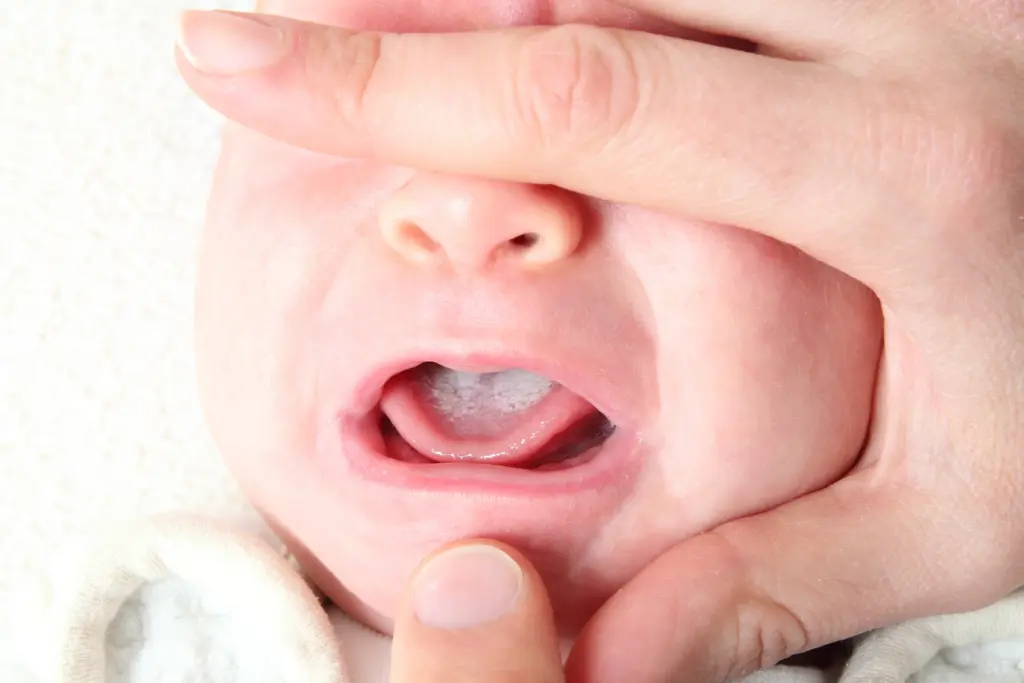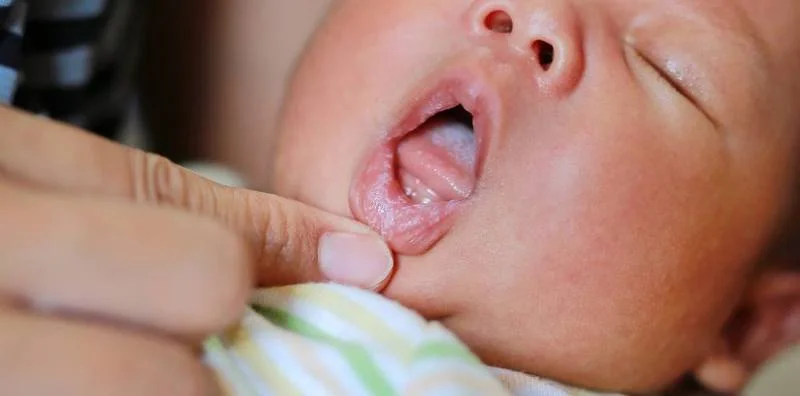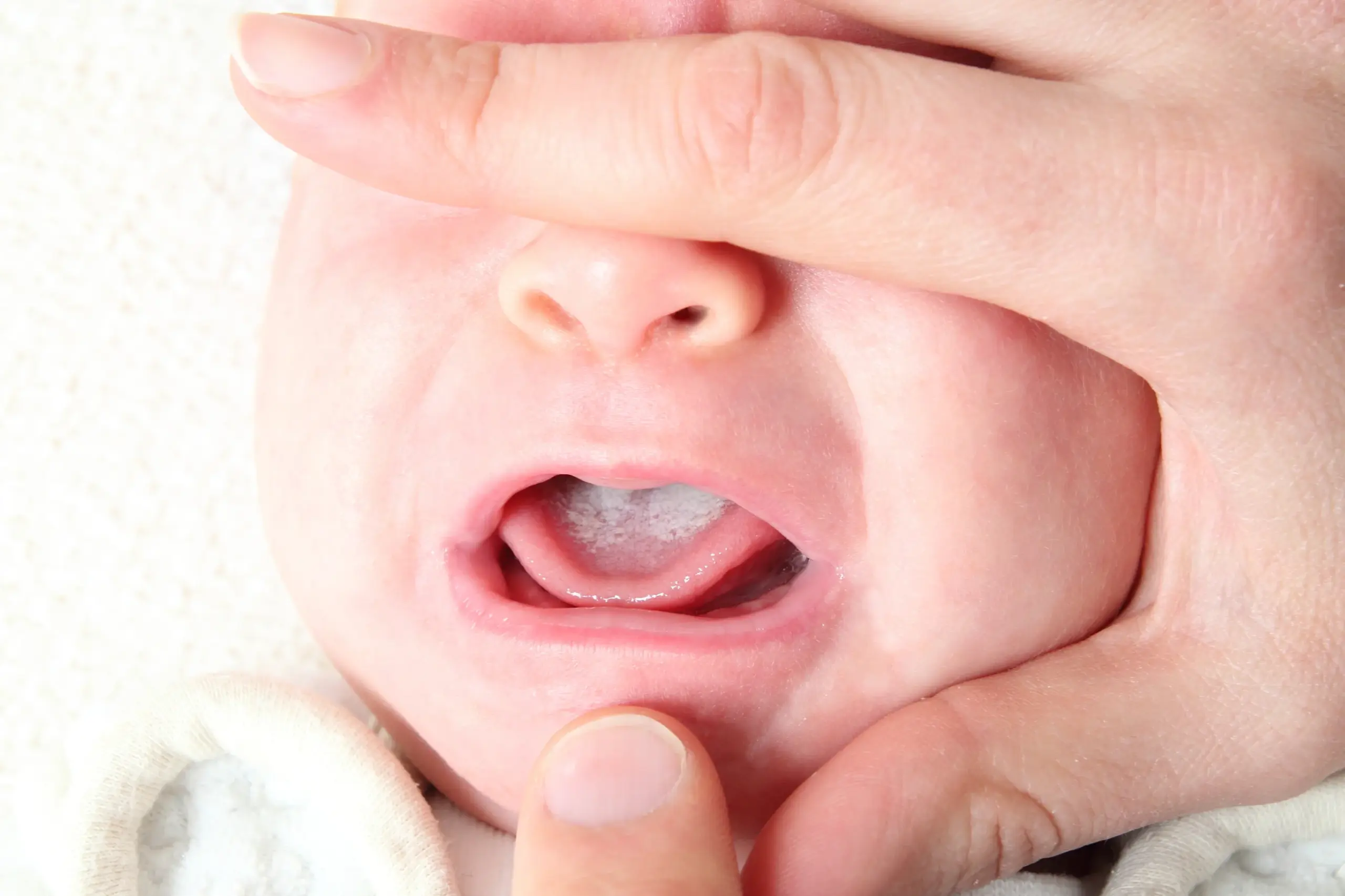Baby thrush is a common but often misunderstood condition that can cause discomfort for both babies and breastfeeding mothers. Understanding how to prevent and treat baby thrush is essential for ensuring the health and well-being of your baby. This comprehensive guide will provide you with detailed information on preventing and treating baby thrush, helping you navigate this condition with confidence.
What is Baby Thrush?
Baby thrush, also known as oral candidiasis, is a fungal infection caused by the overgrowth of Candida albicans in a baby’s mouth. This yeast-like fungus can lead to white patches on the tongue, gums, and inside of the cheeks. Thrush can also affect breastfeeding mothers, causing nipple pain and other symptoms.
Symptoms of Baby Thrush
Identifying Symptoms in Babies
The most common symptoms of baby thrush include:
- White patches inside the mouth that resemble cottage cheese
- Redness or soreness in the mouth
- Fussiness during feeding
- Difficulty swallowing
Symptoms in Breastfeeding Mothers
Mothers can also experience symptoms if the infection spreads to the nipples, including:
- Shiny or flaky skin on the nipples
- Severe nipple pain during and after breastfeeding
- Cracked nipples
- Itching or burning sensation in the nipples
Risk Factors for Baby Thrush
Certain factors can increase the risk of developing thrush in babies, such as:
- Antibiotic use: Antibiotics can disrupt the natural balance of bacteria in the mouth and body, leading to fungal overgrowth.
- Weakened immune system: Babies with compromised immune systems are more susceptible to infections.
- Use of pacifiers and bottles: Prolonged use of pacifiers and bottles can create a moist environment conducive to fungal growth.
- Maternal infections: If a mother has a vaginal yeast infection during delivery, the baby can acquire the fungus.

Diagnosis of Baby Thrush
Thrush is typically diagnosed by a healthcare professional through a physical examination of the baby’s mouth. In some cases, a sample of the affected area may be taken for laboratory testing to confirm the presence of Candida.
Home Diagnosis Methods
Parents can also check for thrush at home by looking for white patches that cannot be wiped away and signs of discomfort during feeding. However, a medical diagnosis is recommended to confirm the condition and determine the appropriate treatment.
Prevention of Baby Thrush
Importance of Good Hygiene Practices
Maintaining good hygiene is crucial in preventing thrush. Simple practices such as washing hands before handling the baby and keeping feeding equipment clean can significantly reduce the risk of infection.
Strategies for Preventing Thrush
To prevent thrush, consider the following strategies:
- Regularly clean and sterilize feeding equipment.
- Wash the baby’s hands and face frequently.
- Ensure the baby’s mouth is cleaned regularly, especially after feeding.
Proper Feeding Practices
Breastfeeding Techniques to Prevent Thrush
Proper breastfeeding techniques can help prevent thrush:
- Ensure a good latch to prevent nipple damage.
- Allow nipples to air dry after feeding.
- Use breast pads that wick away moisture and change them frequently.
Bottle-Feeding Best Practices
For bottle-fed babies:
- Sterilize bottles and nipples before each use.
- Avoid leaving bottles in the baby’s mouth for extended periods.
Sterilizing Feeding Equipment
How to Properly Sterilize Bottles and Pacifiers
To properly sterilize feeding equipment:
- Boil bottles, nipples, and pacifiers for at least 5 minutes.
- Use a sterilizer or dishwasher with a sterilizing cycle if available.
- Regularly replace worn-out or damaged equipment.
Importance of Regular Cleaning
Regular cleaning prevents the build-up of bacteria and fungi. After each use, wash feeding equipment with hot, soapy water and rinse thoroughly before sterilizing.
Maintaining Oral Hygiene for Babies
Techniques for Cleaning a Baby’s Mouth
To clean your baby’s mouth:
- Use a soft, damp cloth to gently wipe the gums and tongue.
- For older babies, use a baby toothbrush with water or a small amount of fluoride-free toothpaste.
Products to Use for Oral Hygiene
Products that can help maintain oral hygiene include:
- Soft baby toothbrushes
- Fluoride-free toothpaste
- Sterilized water
Maintaining Maternal Hygiene
Importance of Breast Hygiene for Breastfeeding Mothers
Breastfeeding mothers should maintain good breast hygiene to prevent thrush:
- Wash hands before and after breastfeeding.
- Clean breasts with warm water and let them air dry.
Tips for Maintaining Clean and Healthy Nipples
Additional tips include:
- Avoid using soap on nipples as it can cause dryness and cracking.
- Change nursing pads frequently to keep the area dry.
Diet and Thrush Prevention
Foods That Can Help Prevent Thrush
Certain foods can help prevent thrush by promoting a healthy balance of bacteria:
- Yogurt with live cultures
- Garlic
- Coconut oil
- Leafy greens
Foods to Avoid
Avoid foods that can promote fungal growth, such as:
- Sugary foods and drinks
- Refined carbohydrates
- Processed foods
Natural Remedies for Thrush Prevention
Safe and Effective Natural Remedies
Natural remedies that can help prevent thrush include:
- Probiotics: Beneficial bacteria that help maintain a healthy balance in the body.
- Coconut oil: Has antifungal properties and can be used to clean the baby’s mouth.
- Apple cider vinegar: Diluted and used as a mouth rinse for older babies and mothers.
How to Use These Remedies
Use natural remedies safely by:
- Consulting a healthcare provider before use.
- Applying coconut oil to the affected area with a clean cloth.
- Using probiotics as directed by a healthcare provider.
Treatment of Baby Thrush
Overview of Treatment Options
Treatment options for baby thrush include:
- Antifungal medications
- Home remedies
- Over-the-counter treatments
How to Choose the Right Treatment
Choosing the right treatment depends on the severity of the infection and the baby’s age. Consult a healthcare provider for personalized advice.
Medical Treatments for Baby Thrush
Commonly Prescribed Medications
Common medications include:
- Nystatin: An antifungal medication applied directly to the affected area.
- Fluconazole: An oral antifungal medication used for severe cases.
How to Administer These Medications
Administer medications as directed by your healthcare provider. For topical treatments, apply the medication to the affected area using a clean applicator.
Over-the-Counter Treatments
Available Over-the-Counter Options
Over-the-counter treatments include antifungal creams and oral gels. Consult a pharmacist or healthcare provider before use.
Pros and Cons of These Treatments
Pros:
- Convenient and accessible
- Can provide quick relief
Cons:
- May not be as effective as prescription medications
- Potential for side effects
Home Remedies for Baby Thrush
Effective Home Remedies
Home remedies for thrush include:
- Baking soda solution: Mix 1 teaspoon of baking soda in 1 cup of water and use a clean cloth to apply to the affected area.
- Coconut oil: Apply directly to the white patches in the mouth.
How to Safely Use Home Remedies
Ensure the safety of home remedies by:
- Consulting a healthcare provider before use
- Using clean, sterile equipment
- Monitoring for any adverse reactions
Treating Thrush in Breastfeeding Mothers
Medications for Mothers
Mothers can use antifungal creams and oral medications as prescribed by their healthcare provider to treat nipple thrush.
Home Remedies for Mothers
Home remedies for mothers include:
- Applying coconut oil to the nipples
- Using a diluted vinegar rinse after breastfeeding
Preventing Recurrence of Thrush
Strategies to Prevent Thrush from Returning
To prevent recurrence:
- Maintain strict hygiene practices
- Continue sterilizing feeding equipment
- Monitor diet and use probiotics if recommended
Importance of Ongoing Hygiene Practices
Consistent hygiene practices are essential to prevent thrush from returning. Regular cleaning and sterilization of feeding equipment and maintaining personal hygiene are crucial.
Complications of Untreated Thrush
Potential Complications for Babies
Untreated thrush can lead to:
- Severe discomfort and difficulty feeding
- Spread of infection to other parts of the body
Complications for Breastfeeding Mothers
For mothers, untreated thrush can cause:
- Chronic nipple pain and damage
- Potential spread of infection
When to See a Doctor
Signs That Require Medical Attention
Seek medical attention if:
- Symptoms persist despite treatment
- The baby refuses to feed
- The infection spreads or worsens
Preparing for a Doctor’s Visit
Prepare for a doctor’s visit by:
- Keeping a record of symptoms and duration
- Bringing a list of any treatments tried
Long-Term Effects of Baby Thrush
Potential Long-Term Impacts on Babies
Most cases of thrush do not have long-term effects if treated promptly. However, severe or untreated cases can impact feeding and growth.
Long-Term Effects on Breastfeeding Mothers
Persistent thrush can lead to long-term nipple damage and may affect breastfeeding success.
Psychological Impact on Parents
Emotional Toll of Dealing with Thrush
Dealing with thrush can be emotionally draining for parents, leading to feelings of frustration and helplessness.
Coping Strategies for Parents
Coping strategies include:
- Seeking support from family and friends
- Joining support groups
- Practicing self-care
Myths and Facts About Baby Thrush
Debunking Common Myths
Common myths include:
- Myth: Thrush only occurs in dirty environments.
- Myth: Thrush will go away on its own without treatment.
Providing Evidence-Based Information
Provide accurate information by:
- Consulting reputable sources
- Following healthcare provider recommendations

Personal Stories and Anecdotes
Real-Life Experiences from Parents
Hearing from other parents who have dealt with thrush can provide valuable insights and support.
Lessons Learned and Practical Advice
Learning from others’ experiences can help you find effective strategies and feel less isolated.
Resources for Further Reading
Recommended Books and Articles on Baby Thrush
Explore books and articles by healthcare professionals for more information on preventing and treating thrush.
Online Forums and Support Groups
Join online communities where you can connect with other parents, share experiences, and find support.










